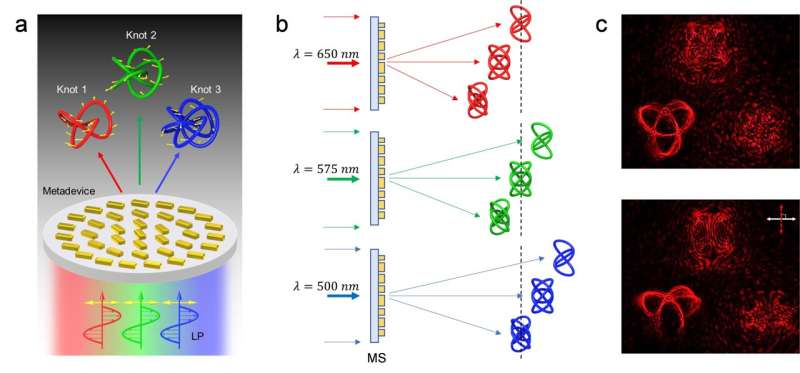Color-selective, three-dimensional polarization structures

Polarization has been a central concept to our understanding of optics and has found many applications ranging from quantum science to our daily life. 3D polarization structures possess peculiar optical features and extra degrees of freedom for carrying information.
There has been much advancement in the theoretical understanding of 3D polarization structures to further our knowledge, but the experimental research has not advanced at the same rate. This is essentially due to the technical and fundamental challenges in creating 3D polarization profiles with conventional methods.
The emergent ultrathin optical metasurfaces have shown much promise for 3D polarization manipulation, and multispectral polarization manipulation will add more degrees of freedom. Furthermore, multifunctional optical devices have profound implications for the research fields where light weight and integrated optical systems are highly desirable. There is an urgent need to develop multifunctional ultrathin devices that can simultaneously encode color and intensity information into 3D polarization profiles. How to realize color selective 3D polarization structures, however, has not been reported.
In a new paper published in Light Science & Application, a team of scientists, led by Professor Xianzhong Chen from School of Engineering and Physical Sciences, Heriot-Watt University, U.K., and Prof. Shuang Zhang from the Department of Electronic & Electrical Engineering, University of Hong Kong, China, and co-workers have developed a single metasurface to realize color-selective 3D polarization structures. The geometric metasurfaces were designed based on color and phase multiplexing and polarization rotation, creating various 3D polarization knots.
Remarkably, different 3D polarization knots in the same observation region can be achieved by controlling the incident wavelengths, providing unprecedented polarization control with color information in 3D space. The efficacy of this approach was exemplified through the demonstration of multiple 3D knots with controlled local polarization states. In the same observation region, different polarization knots were realized by controlling the incident wavelengths. This work has potential applications in vector beam generation, virtual reality, color displays, information security, anti-counterfeiting, and high-density information storage.
The metasurface consists of gold nanorods with spatially variant orientations. The metasurface can be manipulated to generate different 3D polarization structures and realize color-selective functionality. It can perform a challenging optical task with a single device. These scientists summarize the operational principle of this novel device:
"We aim to create multiple 3D polarization structures, together with engineered intensity and color information, by developing novel ultrathin optical devices using optical metasurfaces. A single metasurface device that can change a linearly polarized incident light beam into multiple 3D knots with different predesigned polarization states along the light propagation direction. In the same observation region, different polarization structures are realized by controlling the incident wavelengths."
"The flexible and controllable generation of 3D polarization distributions with customized intensity profiles of different colors (wavelengths) may open a new door to many practical applications" they added.
"Our design method combines the color information and 3D polarization manipulation, offering more degree of freedom for polarization engineering and enabling the realization of wavelength selective functionality. The unique properties of the developed metasurface devices may promote both fundamental research (e.g., complex 3D polarization structures) and practical applications (e.g., virtual reality and anti-counterfeiting)," the scientists said.
More information: Yuttana Intaravanne et al, Color-selective three-dimensional polarization structures, Light: Science & Applications (2022). DOI: 10.1038/s41377-022-00961-y
Journal information: Light: Science & Applications
Provided by Light Publishing Center, Changchun Institute of Optics, Fine Mechanics And Physics, CAS




















